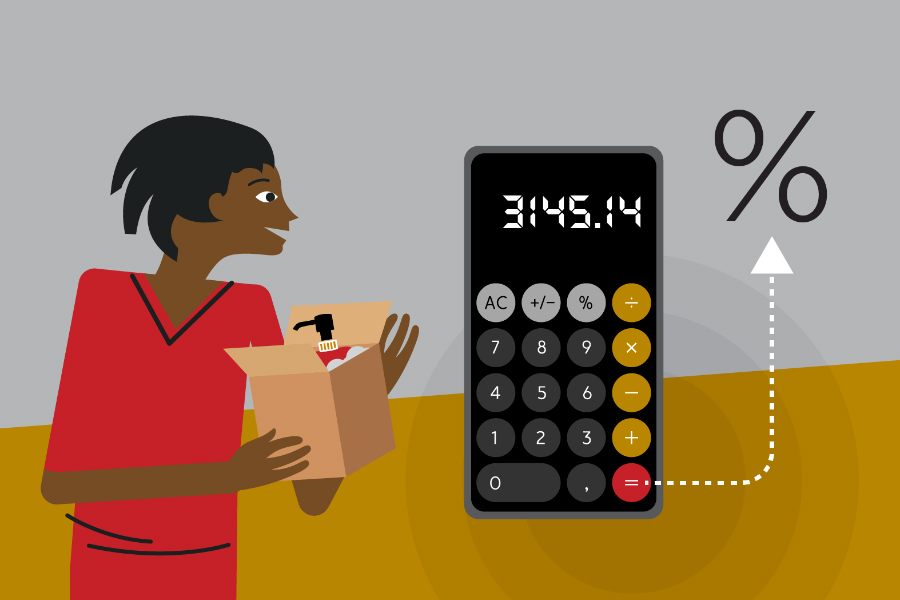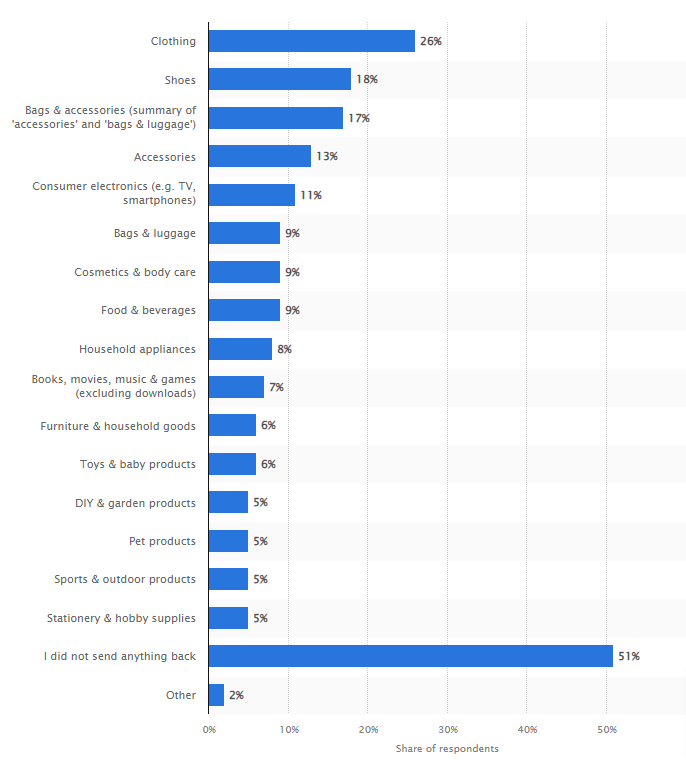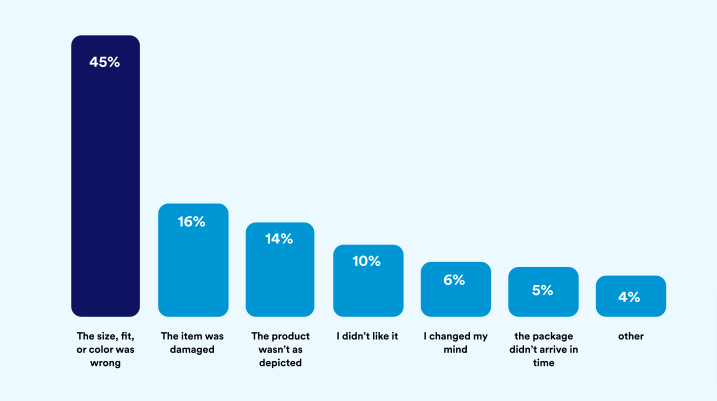Logística de Transporte
Industrias

[Updated post from July 1, 2021]
It's impossible to talk about e-commerce without talking about returns. As e-commerce return rates continue to skyrocket, this is leaving brands scratching their heads and asking how they can meet customer expectations for easy, free returns without becoming unprofitable.
According to the National Retail Federation, consumers returned an estimated $816 billion worth of retail merchandise purchased online during 2022 - a return rate of 16.5% of total retail sales. Of this, 10.7% are considered to involve return fraud.
It's not surprising that some retailers are taking a more punitive approach to returns, with global brands including Zara, H&M, and Boohoo now choosing to charge for returns to offset reverse logistics costs.
It's still too early to tell whether this strategy will help or hurt online sales growth. So, is it possible to lower your e-commerce return rate without resorting to more extreme measures?
But before we can dive into ways to lower your return rate, you need to understand how return rates are calculated – and why your e-commerce return rate should never be taken at face value.
Your e-commerce return rate refers to how frequently customers return items at your online store. Your return rate is represented as a percentage of the total number of sales within a certain timeframe.
The rate of online returns differs widely between retailers. This depends on two key factors:
This is why return rates in e-commerce should never be taken at face value. Yet this is exactly what happens in discussions about the ‘plague of returns' in online shopping. We see lots of scary statistics, such as Wall Street Journal talking about e-commerce returns jumping 70% in 2020 compared with 2019. But this tells us little about what is happening on the ground.
This is why it's vital to situate your return rate in the context of consumer behavior and your returns management strategy. By understanding why returns are happening, e-commerce businesses can achieve effective returns optimization - without resorting to desperate measures.
Calculating your e-commerce return rate is very simple. You divide the amount of merchandise returned by the total amount of merchandise sold.
So, if you sold 15,000 units within six months while 5000 units were returned, your return rate would be:
5000 / 15,000 x 100 = 33%
However, your return rate is a very high-level metric. It doesn't answer the why or how about the returns that are taking place.
Your average e-commerce return rate doesn't tell you how many returns were preventable with the right intervention. or how many returns were converted into exchanges. This is why your e-commerce return rate should always be broken down into two key metrics: Your refund rate and your exchange rate.
Your refund rate is exactly what it sounds like: the total number of refunds given out versus the total number of returns.
To continue with the example with 5000 returned units, but with 1000 refunds, your refund rate would be:
1000 / 5000 x 100 = 20%
Returns and refunds are usually conflated in discussions about returns management. But they are distinct metrics that represent different things.
A customer may have returned a pair of sneakers, but this doesn't mean they've gotten a refund. If they swapped those sneakers for a different size, this exchange doesn't necessarily result in a loss of revenue.
This means that if a customer wants a refund, this could indicate a much deeper issue with the customer experience.
A customer return is often due to a simple change of mind. But there can be more nefarious reasons. They may have received a damaged or defective product, late delivery, or the wrong size or color garment. Scenarios like this can cause online shoppers to fall out of your sales funnel for good. This is why it's important to keep a close eye on your refund rate as a measure of customer satisfaction.
Converting a return into an exchange (or even an upsell) is always the best possible outcome for an e-commerce store.
Your exchange rate is calculated by dividing the number of exchanges by the total number of returned orders. So, with 5000 returned units and 2000 exchanges, your exchange rate would be:
2000 / 5000 x 100 = 40%
In an ideal world, your exchange rate should always be higher than your refund rate. As well as saving you from losing revenue, seamless exchanges add a huge amount of value to the customer experience.
An easy exchange process with expert recommendations and reduce wait times show online customers that you care about offering a positive post-purchase experience, thus increasing brand loyalty.
By tracking your exchange rate, you can understand whether your brand is successful in steering customers toward more desirable return behaviors. If 40% of your returns involved some form of exchange activity, while more than half (60%) were refunds, this indicates you need to do some work to get online shoppers interested in maintaining a relationship with your brand.
E-commerce has traditionally boasted a higher return rate than brick and mortar stores. The main reason for this is the inability of consumers to view and try products in advance, increasing the likelihood of incorrect purchases.
However, key differences in the online shopping journey mean that consumer behaviors are very different than at a physical store.
For example, online retailers use free shipping thresholds to entice customers to spend more when they shop online. But this can encourage customers to add additional items to their cart to qualify, with the intent of returning them later. Bracketing or 'try before you buy' is another popular strategy, where consumers buy multiple versions of the same item and return those that aren't suitable. According to Narvar's 2022 State of Returns study, 63% of consumers surveyed admitted to bracketing at least some of their online purchases.
Return rates can also be skewed by peaks such as the holiday season, which typically create a huge spike in return activity.
These statistics illustrate why it's so important to measure returns by defined periods. For example, the holiday season typically sees a higher volume of returns than the rest of the year due to online shoppers returning gifts. For this reason, the holidays and other big sales events should be segmented from the rest of the year's return activities.
However, an overall return rate doesn't explain how returns vary between different types of products. E-commerce return rates don't look quite so apocalyptic broken down into different product categories.
When we break down return rates by product type, this is where things get a bit more interesting. Statista surveyed a group of consumers to see what products they returned during 2022:

This means that some e-commerce businesses will require more sophisticated returns management strategies than others.
It shouldn't come as a surprise that clothing and footwear see some of the highest return rates in e-commerce, while cosmetics and home furnishings have some of the lowest.
Trying to navigate different color or sizing guides when making online purchases of apparel can be challenging, no matter how good the product imagery is. In this customer journey, the odds of making an incorrect purchase are quite high.
Cosmetics and home decor might not appear to have much in common. But they both provide excellent case studies for how retailers can lower their return rates via AR technology.
From Sephora's Virtual Artist technology to L'Oreal's multi-brand Makeup Genius app, cosmetics brands were among the first to embrace the power of virtual ‘try-ons' using augmented reality.
Likewise, home goods brands like Home Depot and Wayfair have created their own AR apps so consumers can ‘place' items like mirrors or couches within their own homes to aid purchasing decisions.
Augmented Reality allows consumers to ensure an item is suitable before they click ‘purchase'. In fact, over half of consumers (61%) say they prefer to make purchases from an e-commerce website that offers AR technology.
On that note, let's take a closer look at why consumers choose to make returns.
By utilizing 2022 returns data from Narvar, we can see how reasons for returning merchandise affect some product categories more than others:

For example, “the size, fit, or color was wrong” is clearly going to affect apparel and footwear brands the most, while having much less of an effect on a category like electronics.
There are some reasons for e-commerce returns that online retailers can't do much to combat, such as “I didn't like it” or “I changed my mind.” However, other reasons such as damaged items, inaccurate depictions, and late delivery are very much within your brand's control.
So, if you're wanting to combat these avoidable reasons for product returns, here are a few areas to focus on:
Just as there's no such thing as free shipping, there's no such thing as free returns either. Somebody has to foot the bill for reverse logistics – usually the merchant.
To make matters worse, the cost of returns is only getting more expensive over time. Why? Because customer expectations for the returns process have never been higher.
Let's take a look at some stats:
Matters have been made tougher by the COVID-19 pandemic, which has caused consumers to rely more heavily on e-commerce. Some 40% of retailers responded to the pandemic by relaxing their returns policies and turning free return shipping into a standard offering. And with demand surcharges by major carriers now the norm, this can add significantly to retailers' return processing costs.
To calculate the true cost of your returns, you need to consider the following:
Something else that brands need to factor in is the loss of profit margins from e-commerce returns. Only about 48% of returned merchandise is resold at full price, which compounds the cost of return processing.
Moreover, you also need to consider the opportunity costs. If online customers have a poor returns experience, they're unlikely to purchase from you again or recommend your brand to someone else. A negative online review can result in hundreds of lost sales as potential customers choose alternative vendors. In sum, return costs encompass far more than just prepping items to return to the shelf.
Given what we've just talked about, can there ever be such a thing as a ‘good' return rate in e-commerce? Shouldn't returns ideally be as low as possible?
In the e-commerce industry, it's not uncommon to conflate low return rates with customer satisfaction. But just because your return rate is lower than average, it doesn't mean that you're offering a positive customer experience.
If you implement a complex returns policy to discourage customers from making returns, your return rate will drop. Likewise, policies like forcing customers to take store credit instead of a refund help to boost your exchange rate.
But if you're not empowering shoppers to actively choose these options, these metrics are artificial. After all, why would an online shopper want to support a business that doesn't support them? Once that store credit has been redeemed (under duress) that customer is unlikely to shop with you again.
While it seems counterintuitive, the bottom line is that a hassle-free
e-commerce returns process is the key to customer retention. By seeing returns as a tool for growth, they can become a fantastic driver of retained revenue and customer loyalty.
Contrary to popular belief, serial returners can be good for your business. In a recent podcast interview, CEO and co-founder of Happy Returns David Sobie shared that a retailer's most profitable customers are those who make returns more often than average. They buy a lot, but they also return a lot – and most importantly, they keep coming back.
Why? Because consumers want to support brands that make their lives easier, not harder. If your customers have confidence in your returns process, they won't hesitate to purchase from you again. A whopping 92% of shoppers say they would buy again from a retailer if the returns process was easy.
This is why your return rate should never be taken at face value. As we mentioned earlier, a high combined return and exchange rate indicates a positive return experience. It shows that you're maximizing revenue opportunities – and creating happy customers.
So, what does all this mean for how you should be handling online returns?
No merchant wants to see e-commerce sales disappearing down the drain, but it's important to take a long-term view of your returns activity. A customer who returns an item and accepts store credit might make another purchase immediately, in three months – or not at all.
Your returns management strategy has a massive influence over which route your e-commerce customers will take, and whether they will decide to purchase from you again in the future.
This is why you should take a proactive approach to returns management by making the end-to-end returns process not only a positive experience, but genuinely valuable to your business.
So, what does this look like?
In-store returns once accounted for a minority of e-commerce returns, with many brands choosing to silo their returns processes to prevent O2O (online-to-offline) activity.
However, omnichannel returns have undergone a huge change as a result of the pandemic, with consumers showing an increasing preference to return items to a brick-and-mortar store.
According to Narvar, 50% of consumers cite increased convenience and location as their reason for wanting to return in-store, while 42% wanted to shop for other items at the same time.
Buy Online, Return In-Store returns offer an e-commerce store notable advantages. It dramatically reduces return shipping costs by allowing you to ship items in bulk for returns processing, while also ensuring instant refunds for customers. Best of all, brick and mortar returns are your best opportunity to retain revenue by directing customers to replacement products.
Being able to facilitate seamless e-commerce exchanges is the key to keeping refunds down and customer retention high. If exchanges cannot take place within a single transaction, you're adding a lot of friction to the returns process.
Utilizing a return automation tool such as Loop or Returnly allows customers to shop online to facilitate easy, one-click exchanges for different colors or sizes – no tireless searching required. Moreover, data collected from the returns process gives your brand advanced insights into the reasons for customer returns, allowing you to continually take steps to optimize the returns experience.
Outsourcing e-commerce fulfillment is one of the best ways to ensure that your brand is combating online returns at the source. Partnering with an advanced fulfillment provider like Ryder E-commerce by Ryder allows you to automate the initial fulfillment process to prevent costly order errors or damage in transit, some of the most common reasons for negative return experiences.
Take advantage of our SmartRate Selection tool to access the most cost-effective return shipping rates, or leverage our native integrations with state-of-the-art returns management tools to give customers the most seamless returns experience – from returns processing to reconditioning and resale.